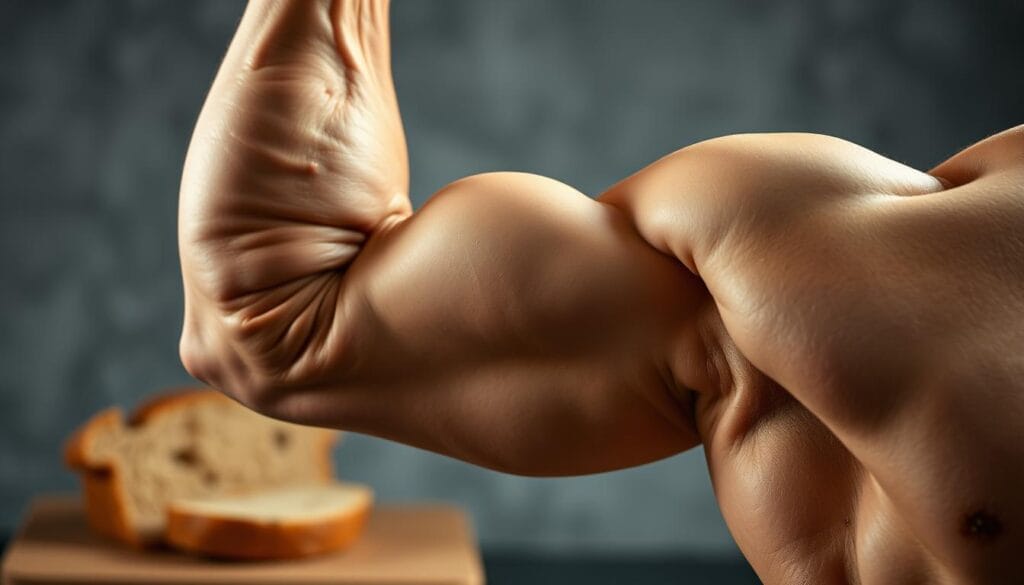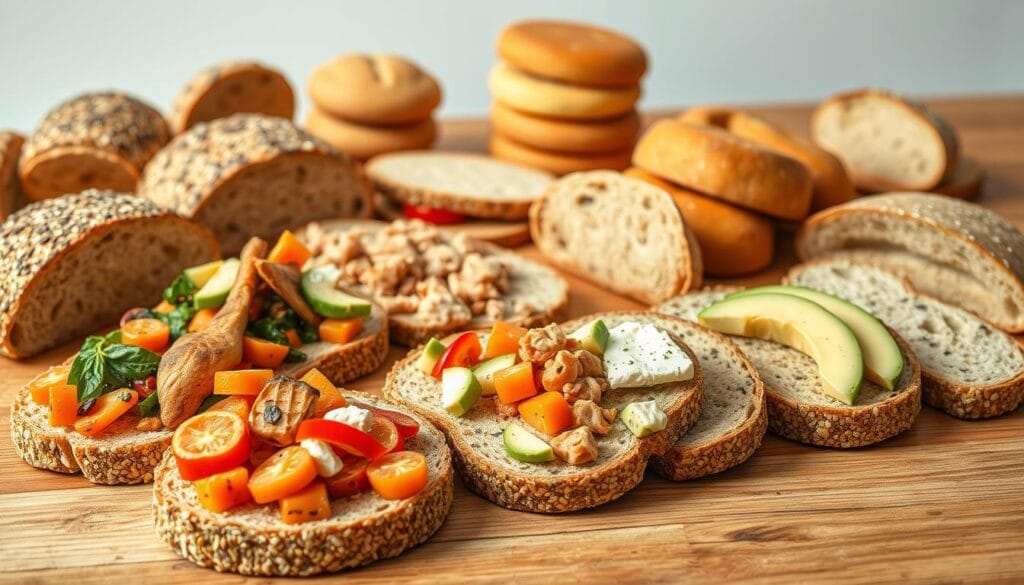High-Protein Bread Recipes: Expert Tips to Boost Meal Prep & Save Time
Busy schedules don’t have to mean sacrificing nutrition. Imagine enjoying flavorful, filling meals that support your goals without hours in the kitchen. That’s where smart recipes with nutrient-rich ingredients shine.
Swapping traditional options for protein-packed alternatives can transform your diet. Experts like Ashley and Lauren Twigge highlight how choosing loaves with 5–7 grams protein per slice fuels muscle growth and keeps you fuller longer. Brands such as Dave’s Killer Bread or Ezekiel 4:9 offer tasty choices loaded with whole grains and seeds.
This guide shares simple ways to upgrade your meal prep. You’ll discover recipes combining nuts, ancient grains, and legumes for extra fiber and vitamins. Each dish is designed to save time—perfect for hectic weekdays.
We’ll also break down how to spot the best options at stores. Learn what to look for on labels and why ingredients matter more than marketing claims. Ready to make every bite count? Let’s dive in.
Table of Contents
Introduction to Protein-Packed Bread
Many people think of traditional loaves as empty calories, but modern recipes flip this narrative. Nutrient-dense alternatives now deliver essential amino acids and sustained energy, making them a smart choice for active lifestyles.
Why You Should Consider High-Protein Bread
Standard varieties often lack fiber and nutrients, leaving you hungry soon after eating. Loaves with added legumes or ancient grains, like Ezekiel’s sprouted blend, provide 4–6 grams of protein per slice. This helps bridge gaps in your daily intake without extra effort.
The Role of Bread in a Balanced Diet
Carbohydrates are vital, but pairing them with quality ingredients matters. Whole wheat options with chia seeds or flax offer a double boost of fiber and plant-based protein. Studies show these combinations support digestion and stabilize blood sugar better than refined flour versions.
Always check labels: terms like “enriched flour” often mask low nutritional value. Brands using quinoa or almond flour typically prioritize wholesome ingredients, ensuring every slice contributes to your goals. Up next, we’ll break down how to spot the best picks at your local grocery store.
Understanding the Protein Content in Bread
Not all loaves are created equal when it comes to fueling your body. The grams of protein per slice can vary dramatically depending on ingredients and preparation methods. This difference impacts how well your meals support energy levels and daily nutrition goals.
Comparing Bread Types: From White to Whole-Grain
Standard white varieties average just 2.5 grams of protein per serving, while whole-wheat options deliver nearly 4 grams. Sprouted grain loaves, like Ezekiel, push this to 5 grams or more. These gains come from whole grains, seeds, and additives like pea protein or egg whites.
Refined carbohydrates dominate white options, offering little fiber or nutrients. In contrast, multigrain choices pack dietary fiber alongside plant-based proteins. This combo slows digestion, helping you feel full longer.
Always check labels: look for “grams protein per slice” near the top. Brands listing quinoa or almond flour often prioritize nutrient-rich recipes. Small swaps here can bridge gaps in your diet without extra effort.
Understanding these differences lets you choose loaves that align with your health priorities. Whether building muscle or managing weight, smarter bread options make every bite work harder.
Key Ingredients That Boost Protein in Bread
The foundation of nutrient-rich loaves lies in their components. Smart selections transform ordinary recipes into sustained energy sources that align with fitness and wellness goals. Let’s explore what elevates these baked goods beyond basic carbohydrates.
Whole Grains, Nuts, and Seeds
Ancient grains like spelt and kamut pack up to 6 grams of protein per serving. They’re also rich in iron and magnesium. Chia or flaxseed additions boost fiber content while adding a satisfying crunch.
Brands such as Dave’s Killer Bread use sunflower seeds and quinoa for texture. These elements enhance dietary value without artificial additives. You’ll often find 3–5 grams of plant-based protein in each slice.
Special Additives: Whey, Egg White, and Pea Protein
Modern recipes often include powdered supplements. Sola bread uses whey to deliver 5 grams of protein per slice, ideal for post-workout recovery. Egg white-enriched options like Carbonaut create fluffy textures with minimal carbs.
Pea protein appeals to plant-based diets. It blends seamlessly into dough, offering a nutrient boost without altering taste. Check labels for these ingredients if you want a protein punch without extra calories.
When shopping, prioritize loaves listing whole grains first. Avoid fillers like corn syrup or hydrogenated oils. Small tweaks in your choices can elevate everyday meals into wholesome fuel for your body.
Expert Tips for Enhancing Your Bread Recipes
Transforming your favorite loaf into a nutrient powerhouse doesn’t require chef-level skills. With a few smart tweaks, you can elevate everyday recipes to support your goals while keeping flavors familiar. Let’s explore how to add more value to each slice.
Simple Swaps for a Protein Punch
Start by replacing 25% of regular flour with chickpea or almond flour. These alternatives add 3–4 grams of plant-based power per serving. For extra texture, mix in sunflower seeds or ground flax—they’ll boost fiber without altering baking times.
Consider adding unflavored whey or pea powder to dough. A tablespoon per cup of flour increases grams per slice by 2–3. Egg whites work too—swap one egg for two whites to cut cholesterol while adding 6 grams of lean fuel.
Test adjustments in small batches. Bake a single roll first to check texture. If it feels dense, add a teaspoon of apple cider vinegar. This helps dough rise while balancing flavors.
Experiment with ratios until you find your sweet spot. One reader shared: “Using half spelt flour and half all-purpose gave my sandwich loaf a nutty taste my family loves.”
These tweaks don’t just amplify nutrition—they create versatile options for snacks or balanced meals. Whether you’re meal-prepping or craving toast, every bite becomes an opportunity to nourish.
Exploring High Protein Bread Options at the Grocery Store
Navigating the bread aisle can feel overwhelming with so many choices. Focus on loaves that deliver both flavor and nutritional value. Look for labels highlighting “grams per slice” and check ingredient lists for whole-food sources like seeds or ancient grains.
Top Product Picks and What to Look For
Hero Classic White offers 10 grams of fuel per slice with 11 grams of fiber. Equii’s multigrain loaf matches this while using fermented grains for easier digestion. For wraps, Mission Tortilla’s Protein Power packs 7 grams per serving—perfect for quick lunches.
Always compare labels side-by-side. Prioritize options listing whole grains like oats or quinoa first. Avoid products with added sugars or preservatives. A good rule: if you can’t pronounce an ingredient, reconsider it.
Seek out brands that balance carbohydrates with nutrients. Better Brand’s Everything Bagel uses chickpea flour to hit 11 grams per serving. This approach keeps meals satisfying without energy crashes.
Remember, quality matters as much as quantity. Loaves rich in flax or chia add omega-3s and antioxidants. Pair these picks with lean proteins and veggies for meals that support your goals effortlessly.
Benefits of Adding High Protein Bread to Your Meals
Upgrading your meals with nutrient-rich slices offers more than convenience—it’s a strategic choice for long-term wellness. These loaves deliver essential fuel while keeping your energy steady throughout the day.

Supporting Muscle Growth and Repair
Active lifestyles demand proper recovery. Each slice packed with 5–7 grams of fuel helps rebuild tissues after workouts. Ashley Twigge notes: “Amino acids from quality sources speed up repair, especially when consumed within two hours of exercise.”
Athletes and weekend warriors alike benefit. Pairing these loaves with eggs or Greek yogurt creates meals that sustain strength gains. This approach ensures your body gets what it needs without extra supplements.
Improving Satiety and Weight Management
Combining fiber with slow-digesting ingredients keeps hunger at bay. Lauren Twigge explains: “This duo stabilizes blood sugar, reducing cravings by 30% in many clients.” You’ll naturally eat less between meals while feeling satisfied.
Studies show balanced meals with these components support healthier body composition. They also provide vitamins like B12 and minerals such as iron—nutrients often lacking in processed snacks.
Choosing wisely means every bite works harder for you. From breakfast toast to post-gym sandwiches, smart swaps make sticking to goals simpler and tastier.
Choosing the Best Bread for Your Dietary Goals
Selecting the right loaf starts with understanding your body’s needs. Whether building strength or maintaining energy, your choice should reflect nutritional priorities without compromising taste. Let’s break down how to decode labels and align options with your unique objectives.
Ingredient Check: What Matters Most
Flip the package and scan the first three items. Whole wheat, oats, or sprouted grains signal quality. Avoid products where refined flours or sugars dominate—these often lack fiber and essential vitamins. A shorter list usually means cleaner fuel for your day.
Prioritize loaves that specify protein sources like pea isolate or egg whites. These additions boost grams per slice while keeping carbs in check. For muscle support, aim for at least 4 grams paired with 3+ grams of fiber. Weight management? Focus on slow-digesting ingredients like chia seeds to curb cravings.
Compare brands side-by-side at the store. Look for options fortified with iron or B vitamins if you’re plant-based. One reader shared: “Switching to a seeded rye with quinoa added 15% more protein to my breakfast—no extra effort.”
Keep a mental checklist: whole grains first, minimal additives, and balanced macros. This approach turns grocery trips into strategic steps toward your health goals. Next, we’ll explore creative ways to use these picks in meals that save time and satisfy.
Innovative Meal Prep Ideas Using Protein-Infused Breads
Revamp your lunchbox with nutrient-dense slices that turn ordinary meals into flavor-packed fuel. These recipes prioritize convenience without skimping on taste or nutrition—perfect for busy weeks.

Creative Sandwiches & Toast Upgrades
Layer thinly sliced turkey breast, avocado, and spinach on seed-enriched sourdough. Drizzle with garlic-infused Greek yogurt for a tangy twist. For breakfast, top multigrain slices with almond butter, banana, and chia seeds—this combo delivers 12 grams of fuel per serving.
Try scrambled eggs with diced peppers on rye. Add a sprinkle of feta for extra calcium. One fitness enthusiast shared: “This keeps me full through morning meetings better than cereal.”
Quick Wraps & Snacks
Swap regular tortillas for sprouted grain versions. Fill them with grilled chicken, shredded cabbage, and a lime-cilantro sauce. Roll tightly and slice into pinwheels for easy grab-and-go bites.
Turn leftover loaves into savory French toast. Dip slices in egg whites mixed with herbs, then pan-fry. Serve with roasted veggies for a balanced dinner in 15 minutes.
For snacks, toast bagel thins and spread with hummus. Top with cucumber ribbons and smoked paprika. These ideas prove that smart ingredients make everyday meals exciting and efficient.
Conclusion
Your journey to better nutrition starts with simple swaps. Choosing loaves packed with wholesome ingredients like seeds, legumes, or ancient grains offers more than flavor—it fuels your body efficiently. These options deliver sustained energy, support muscle repair, and keep cravings in check.
Compare labels to find loaves with at least 5 grams per slice. Brands like Dave’s Killer Bread and Ezekiel use sprouted grains for added “digestibility and nutrient absorption,” as experts recommend. Small tweaks—like adding almond flour to homemade recipes—can amplify fiber and vitamins without extra effort.
Remember, smart choices add up. Swapping one meal daily with these nutrient-rich slices boosts your intake of essential amino acids and minerals. Experiment with wraps, savory toasts, or protein-enhanced French toast to keep meals exciting.
Bookmark this guide for quick reference during grocery runs or kitchen experiments. Every bite brings you closer to lasting health benefits—one slice at a time.

